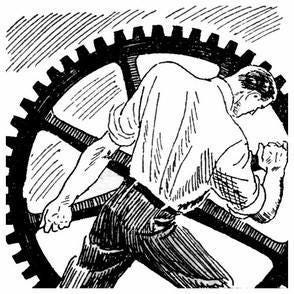A fundamental lesson I learned early after starting at Goldman Sachs in 1982, was it matters how we collect ourselves and our inspire our teams when the markets “Crash”. Financial markets tend to do that from time to time,
A memorable one was of course the Internet crash that started in March 2000, and led to the Internet Tech ‘Wilderness” years through the first decade of the new century. (Disclosure: I led the Firm’s Internet Equities Research team in the nineties).
Most memorable through that period was how one company Amazon.com lost over 90% of its market value and was memorialized on the cover of Barron’s around that time.
Jeff Bezos of course was able to do a victory lap over two decades later.
But the image we should remember the most was the one in the chart below that Bezos used to motivate his troops in the depths of 2001. It’s now famous as the Amazon Flywheel loop.
As this Vox piece (whole piece worth reading) tells us years later in 2019,
“When Amazon was in trouble back in 2001, Jeff Bezos called professor and Good to Great author Jim Collins — and became his best student ever.”
This is what I meant at the beginning above when I said ‘It matters how we collect ourselves and inspire our teams when the markets “Crash”’.
Here’s how Bezos did it at one of the lowest points in Amazon’s history in 2001. As Vox explains:
“That’s when founder and CEO Jeff Bezos called Jim Collins, a former Stanford business professor who had written the widely-admired book Good to Great: Why Some Companies Make the Leap...and Others Don’t. Collins visited Amazon’s campus to talk about some ideas from the book, including a concept he called “turning the flywheel” — in essence, figuring out how to push your business so that it starts to gain momentum, growing faster and faster.
“Now the wonderful thing about great students — and Jeff Bezos and company are really thoughtful, smart people — is they take an idea and then they took it even further,” Collins said on the latest episode of Recode Decode with Kara Swisher. “So they took the flywheel and they said, ‘We’re going to make the flywheel ours.’”
And did they ever. Over the next two decades, as the chart below shows, Bezos and team took the chart and DEEPLY executed every part of it.
Then adapted it to several new businesses, and collectively turned all of that into the Four key businesses that drive Amazon’s $1.2 trillion plus market cap and business today.
Those businesses of course are the Amazon Online Store, Amazon Prime, Amazon 3rd Party Retail, and of course, AWS, their world leading Cloud services business.
The important item to note here is that the sketch, while making the concept easy to understand, understates the ENORMOUS execution challenge to making it work.
As Jim Collins the author explains in the Vox piece:
“Sometimes what I find is that people confuse a really deep understanding of why the flywheel really works with kind of an aspirational set of steps,” Collins said. “[They say,] ‘We want to do customer service and fast delivery and increase in capital. Okay, we’ll list them all out, now let’s just draw a circle.’ That’s not a flywheel. That’s just saying we have a flywheel when it’s just a list of things you want to do.”
“Essentially, think about it this way: The way something becomes great looks to those peering in from the outside is different than the way it feels on the inside. Looking in from the outside it can look like this big, instantaneous breakthrough. All of a sudden, something happened overnight.”
“But if you really look on the inside, it’s like turning a giant, heavy flywheel. The process is like, you start pushing in an intelligent and consistent direction, after a lot of effort you get one giant, slow, creaky turn. You don’t stop, right? You keep pushing. And then you get a second turn and you keep pushing. And then you get four and eight and 16 and 32 and a thousand and a hundred thousand and a million and at some point that flywheel’s got all this cumulative momentum, it’s building, building, building.”
So it’s REALLY, REALLY hard to build this flywheel, get it started, take it to scale and build something that dents the World. In a good way. But Technology, especially, makes these opportunities potentially possible.
The reason I’m going through all this history, is that the latest AI technologies make it possible to build another set of world changing Flywheel loops.
So many are going to have a shot at building both what I call “AI Native” and “AI Add-On businesses, and their own Flywheel Loops.
Chief among them of course is OpenAI, the ‘overnight success’ story behind ChatGPT. Working in Herculean ways to dent the universe with AI. In as good a way as possible.
And Founder/CEO Sam Altman has his potential Amazon Flywheel Loop to build.
I’ve taken the liberty of sketching one out in the chart below. But the details can be modified and variants can be built. Will have more to say on OpenAI’s possible Flywheel loops in future posts.
The key is that it’s going to take a lot of in depth execution. And a fair bit of time and resources. Oh, and while a whole lot of startups and incumbents are building their own to grind OpenAI down.
And I’ll have a lot more to say about flywheels and loops for OpenAI and as a whole host of new AI businesses get built.
But for now, to paraphrase, it’s time to put shoulders to the Flywheels. Amazon showed the way. Stay tuned.








